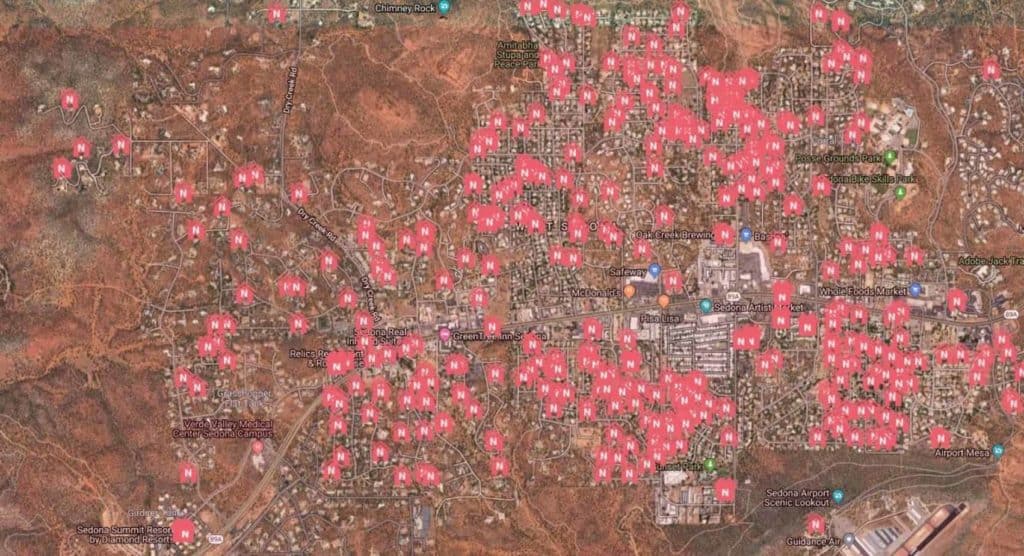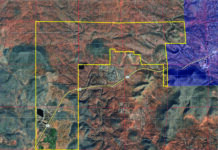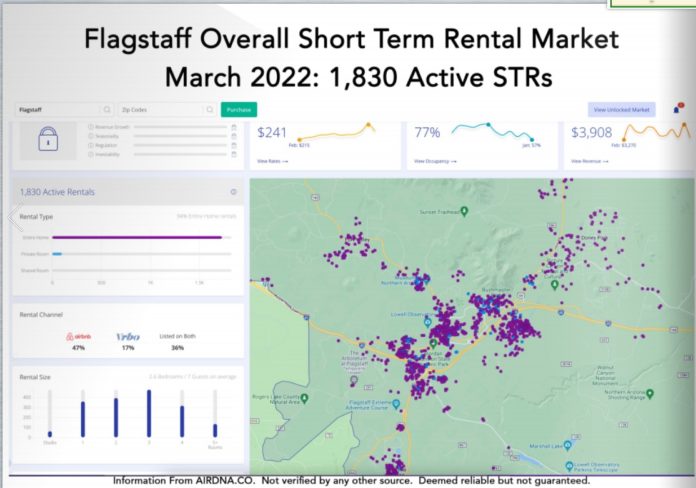It’s important to know that Sedona is not the only community in the state, nor the only in Northern Arizona suffering from the blight of unchecked vacation rentals vaporizing the housing market and turning residential neighborhoods into de facto commercial lodging zones.
A friend in Flagstaff recently forwarded me “Flagstaff Short-Term Rental Market Overview” report from a real estate firm in that city. According to the report, there are 1,830 active short-term rentals in the Flagstaff area, about 7.47% of the 24,446 total households in Flagstaff. In human terms, with an average 2.52 people per household, that absence of long-term rentals means vacationers are occupying the space that could be used by 4,629 full-time residents. Our neighbors up the hill are incensed by the influx.
Yet here in Sedona, the Village of Oak Creek and the immediate environs, about 2,599 of our 8,228 households are active vacation rentals, according to AirDNA.
While greater in number, it is also a larger percentage, an estimated 31.59%. The human toll means there is space for 6,550 would-be Sedona residents instead being rented out to tourists. Given that the total number of physical homes and housing units have increased since the 2010 Census, but our total number of residents has fallen by several hundred, it’s not hard to see vacation rentals as a major factor in this dissonance.

Of those 2,599, five companies own and/or manage 461 of them, meaning these are not local homeowners renting out a room to make ends meet or turn the guest house into a quaint bed and breakfast, but nakedly profit-driven commercial investments with zero concern about we residents next door.
Our total housing stock of both rentals and homes for sale, is down to just 15% of what it was before Senate Bill 1350 legalized rentals in 2015.
After Larson Newspapers’ journalist Juliana Walter reported this last month, it took some real estate agents zero time to cite our story in their social media posts as a reason why potential short-term rental property buyers looking in Sedona should rely on them to find these hard-to-find homes. Always Be Closing, I suppose.
According to the Flagstaff report, short-term rental units there have an average daily rate of $241 while AirDNA estimates Sedona’s average daily rate is $292.
A family renting a house for $1,600 per month — the average rental rate for a modest home in Sedona before rents shot through the roof after 2015 due to the competition from vacation rentals — is paying roughly $52 per day in rent.
Nearly all of the homes in the Sedona market were the same homes that owners were charging reasonable, if higher than average, rates pre-2015, and despite a paint job, some cosmetic improvements, regular professional cleaning and some new appliances, aren’t significantly improved, at least not to the point of justifying a six-fold increase. Yet tourists are willing to pay inflated costs for often mediocre lodging that a local family would instead love to rent, quirks and all. The profit margin is clear and completely understandable, but the corporatization and oversaturation is spawning ire and backlash.
One solution recently floated on local social media would be for the city or state to raise vacation rental taxes to cut the profit margin, but owners would likely just pass costs onto tourists.
But there are bills still in the Arizona State Legislature, notably House Bill 2711, which would “limit the number of vacation rentals and short-term rentals based on a percentage of total residentially zoned buildings or structures in that city or town” and allow local governments to “regulate vacation rentals or short-term rentals in the same manner as” hotels, etc.
The bill doesn’t state what that percentage is, and it’s unclear if legislators will set it or if local communities will. The bill passed the House Land, Agriculture & Rural Affairs Committee Action with a 10-1 vote, the only opponent being Arizona Rep. Gail Griffin [R-District 14], a real estate broker whose primary campaign donor is the Arizona Association of Realtors.
It skirts Proposition 207 under the health and safety provision and offers no respite for “grandfathered” vacation rentals. The requirement for a limited number of permits means there will be a mad dash to score one at city halls statewide should the bill be signed into law.
Sedona hired a lobbyist on this issue, which might be the best money the city has spent in years if this bill passes. If our city should fail, other cities, like Flagstaff are also confronting this housing debacle.
Christopher Fox Graham
Managing Editor



















